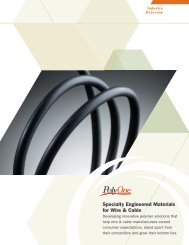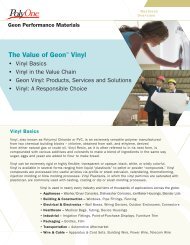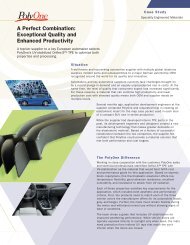PolyOne 2009 Annual Report
PolyOne 2009 Annual Report
PolyOne 2009 Annual Report
You also want an ePaper? Increase the reach of your titles
YUMPU automatically turns print PDFs into web optimized ePapers that Google loves.
POLYONE CORPORATION<br />
Shipping and Handling Costs<br />
Shipping and handling costs are included in cost of sales.<br />
Research and Development Expense<br />
Research and development costs, which were $22.9 million in<br />
<strong>2009</strong>, $26.5 million in 2008 and $21.6 million in 2007, are<br />
charged to expense as incurred.<br />
Environmental Costs<br />
We expense costs that are associated with managing hazardous<br />
substances and pollution in ongoing operations on a current basis.<br />
Costs associated with the remediation of environmental contamination<br />
are accrued when it becomes probable that a liability has<br />
been incurred and our proportionate share of the cost can be<br />
reasonably estimated.<br />
Equity Affiliates<br />
We account for our investments in equity affiliates under FASB ASC<br />
Topic 323, Investments — Equity Method and Joint Ventures. We<br />
recognize our proportionate share of the income of equity affiliates.<br />
Losses of equity affiliates are recognized to the extent of our<br />
investment, advances, financial guarantees and other commitments<br />
to provide financial support to the investee. Any losses in<br />
excess of this amount are deferred and reduce the amount of future<br />
earnings of the equity investee recognized by <strong>PolyOne</strong>. As of December<br />
31, <strong>2009</strong> and 2008, there were no deferred losses related to<br />
equity investees.<br />
We recognize impairment losses in the value of investments<br />
that we judge to be other than temporary. See Note 4, Financial<br />
Information of Equity Affiliates, for more information.<br />
Share-Based Compensation<br />
We account for share-based compensation under the provisions of<br />
FASB ASC Topic 718, Compensation — Stock Compensation, which<br />
requires us to estimate the fair value of share-based awards on the<br />
date of grant using an option-pricing model. The value of the portion<br />
of the award that is ultimately expected to vest is recognized as<br />
expense over the requisite service periods in the accompanying<br />
consolidated statements of operations. As of December 31, <strong>2009</strong>,<br />
we had one active share-based employee compensation plan, which<br />
is described more fully in Note 15, Share-Based Compensation.<br />
Income Taxes<br />
Deferred tax liabilities and assets are determined based upon the<br />
differences between the financial reporting and tax basis of assets<br />
and liabilities and are measured using the tax rate and laws currently<br />
in effect. In accordance with FASB ASC Topic 740, Income<br />
Taxes, we evaluate our deferred income taxes to determine whether<br />
a valuation allowance should be established against the deferred<br />
tax assets or whether the valuation allowance should be reduced<br />
based on consideration of all available evidence, both positive and<br />
negative, using a “more likely than not” standard.<br />
New Accounting Pronouncements<br />
Consolidation — In June <strong>2009</strong>, the FASB issued new guidance that<br />
modifies how a company determines when an entity that is insufficiently<br />
capitalized or is not controlled through voting (or similar<br />
rights) should be consolidated. The new guidance clarifies that the<br />
determination of whether a company is required to consolidate an<br />
entity is based on, among other things, an entity’s purpose and<br />
design and a company’s ability to direct the activities of the entity<br />
that most significantly impact the entity’s economic performance. A<br />
requirement of the new guidance is an ongoing reassessment of<br />
whether a company is the primary beneficiary of a variable interest<br />
entity. Additional disclosures are also required about a company’s<br />
involvement in variable interest entities and any significant changes<br />
in risk exposure due to that involvement. The new requirements are<br />
effective for fiscal years beginning after November 15, <strong>2009</strong> and<br />
are effective for us on January 1, 2010. The adoption of this<br />
guidance will not materially affect our financial statements.<br />
Subsequent Events — In May <strong>2009</strong>, the FASB issued new guidance<br />
to establish general standards of accounting for and disclosure of<br />
events that occur after the balance sheet date but before financial<br />
statements are issued or are available to be issued. The new<br />
guidance also requires entities to disclose the date through which<br />
subsequent events were evaluated as well as the rationale for the<br />
date that was selected and is effective for interim and annual<br />
periods ending after June 15, <strong>2009</strong>. Refer to Note 22, Subsequent<br />
Events.<br />
Fair Value Measurements and Disclosures — In September 2006,<br />
the FASB issued new guidance regarding fair value measurements,<br />
which defines fair value, establishes the framework for measuring<br />
fair value under U.S. generally accepted accounting principles and<br />
expands disclosures about fair value measurements. In February<br />
2008, the FASB issued further guidance that delayed the effective<br />
date of fair value measurements for all nonfinancial assets and<br />
nonfinancial liabilities, except those that are recognized or disclosed<br />
at fair value in the financial statements on a recurring basis,<br />
to fiscal years beginning after November 15, 2008. The adoption of<br />
this new guidance on January 1, <strong>2009</strong>, for all nonfinancial assets<br />
and nonfinancial liabilities, did not have a material impact on our<br />
financial statements. See Note 19, Fair Value, for information on our<br />
assets and liabilities measured at fair value.<br />
Business Combinations — In December 2007, the FASB issued<br />
new guidance that establishes principles over the method entities<br />
use to recognize and measure assets acquired and liabilities<br />
assumed in a business combination and enhances disclosures<br />
of business combinations. The new guidance is effective for business<br />
combinations completed on or after January 1, <strong>2009</strong>. The<br />
adoption of this new guidance did not materially impact our <strong>2009</strong><br />
financial statements. Refer to Note 20, Business Combinations.<br />
Derivatives and Hedging — In March 2008, the FASB issued new<br />
guidance that requires qualitative disclosures about objectives and<br />
strategies for using derivatives, quantitative disclosures about fair<br />
value amounts of and gains and losses on derivative instruments,<br />
and disclosures about credit-risk-related contingent features in<br />
42



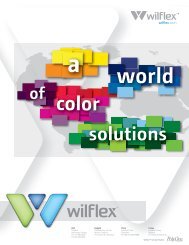
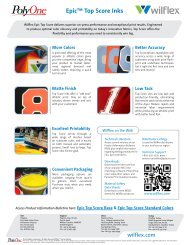
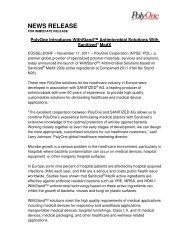

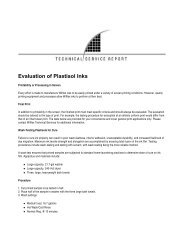
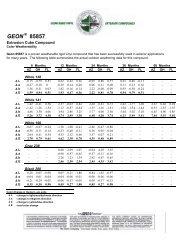
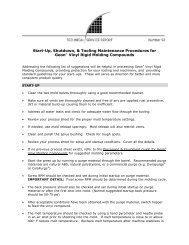
![TPE Injection Molding Guide [PDF] - GLS Thermoplastic Elastomers](https://img.yumpu.com/26329362/1/190x245/tpe-injection-molding-guide-pdf-gls-thermoplastic-elastomers.jpg?quality=85)

